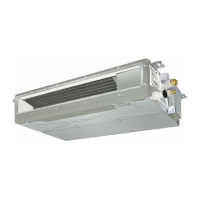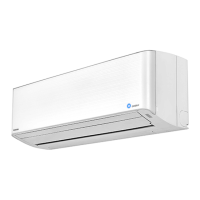Do you have a question about the Toshiba RAS-M16SKV-E and is the answer not in the manual?
Safety measures for power supply, installation, and general operation.
Safety guidelines for handling R410A refrigerant and required tools.
Precautions for electrical work, power disconnection, and high voltage circuits.
Warnings for installation locations, wiring, grounding, and environmental hazards.
Cautions regarding unit placement, sharp edges, and earthquake preparedness.
Details on outdoor unit compatibility with indoor models.
Comprehensive specifications for indoor units including electrical, noise, and physical attributes.
Safety guidelines for handling R410A during installation and servicing.
Information on copper pipes and joints used for refrigerant piping.
Procedures and precautions for flaring copper pipes to prevent refrigerant leaks.
Tables detailing flare processing dimensions for R410A and R22 refrigerants.
Procedures and precautions for connecting flares, including tightening torque.
Lists tools exclusive to R410A and general tools for installation and maintenance.
Step-by-step procedure for recharging refrigerant in the air conditioner system.
Brazing materials, flux usage, and methods to prevent oxidation.
Diagram showing the construction and dimensions of the indoor unit.
Diagram and dimensions for installing the mounting plate for the indoor unit.
Wiring diagram for indoor and outdoor units of M10 and M13 series models.
Wiring diagram specific to the RAS-M16SKV-E and RAS-M16SKCV-E models.
Specifications for key electrical components within the indoor unit.
Diagram illustrating the refrigerant flow and key pipe specifications.
Block diagram detailing the control functions and connections of the indoor unit.
Overview of the control system, unit roles, and signal communication.
Defines the specific roles and functions of the indoor and outdoor unit controllers.
Explains basic operation and modes like AUTO, DRY, ECO, QUIET.
Details advanced features like COMFORT SLEEP, timers, Hi-POWER, Self-Cleaning.
Instructions for operating the remote controller and understanding its display.
Function for automatic restart after power failure and how to set it up.
How to save and recall preferred operation settings for future use.
Diagrams and procedures for installing indoor and outdoor units, including pipe preparation.
Guidelines for electrical work, power supply, and connecting cables.
Procedures for forming pipes and installing the drain hose correctly.
Methods for diagnosing problems, including initial checks, LED codes, and self-diagnosis.
Flowcharts to diagnose troubles based on common symptoms like no power or fan issues.
Step-by-step instructions for replacing major components of the indoor unit.
Exploded diagrams and a list of parts for the indoor unit.
Safety measures for power supply, installation, and general operation.
Safety guidelines for handling R410A refrigerant and required tools.
Precautions for electrical work, power disconnection, and high voltage circuits.
Warnings for installation locations, wiring, grounding, and environmental hazards.
Cautions regarding unit placement, sharp edges, and earthquake preparedness.
Details on outdoor unit compatibility with indoor models.
Comprehensive specifications for indoor units including electrical, noise, and physical attributes.
Safety guidelines for handling R410A during installation and servicing.
Information on copper pipes and joints used for refrigerant piping.
Procedures and precautions for flaring copper pipes to prevent refrigerant leaks.
Tables detailing flare processing dimensions for R410A and R22 refrigerants.
Procedures and precautions for connecting flares, including tightening torque.
Lists tools exclusive to R410A and general tools for installation and maintenance.
Step-by-step procedure for recharging refrigerant in the air conditioner system.
Brazing materials, flux usage, and methods to prevent oxidation.
Diagram showing the construction and dimensions of the indoor unit.
Diagram and dimensions for installing the mounting plate for the indoor unit.
Wiring diagram for indoor and outdoor units of M10 and M13 series models.
Wiring diagram specific to the RAS-M16SKV-E and RAS-M16SKCV-E models.
Specifications for key electrical components within the indoor unit.
Diagram illustrating the refrigerant flow and key pipe specifications.
Block diagram detailing the control functions and connections of the indoor unit.
Overview of the control system, unit roles, and signal communication.
Defines the specific roles and functions of the indoor and outdoor unit controllers.
Explains basic operation and modes like AUTO, DRY, ECO, QUIET.
Details advanced features like COMFORT SLEEP, timers, Hi-POWER, Self-Cleaning.
Instructions for operating the remote controller and understanding its display.
Function for automatic restart after power failure and how to set it up.
How to save and recall preferred operation settings for future use.
Diagrams and procedures for installing indoor and outdoor units, including pipe preparation.
Guidelines for electrical work, power supply, and connecting cables.
Procedures for forming pipes and installing the drain hose correctly.
Methods for diagnosing problems, including initial checks, LED codes, and self-diagnosis.
Flowcharts to diagnose troubles based on common symptoms like no power or fan issues.
Step-by-step instructions for replacing major components of the indoor unit.
Exploded diagrams and a list of parts for the indoor unit.
| Type | Split System |
|---|---|
| Cooling Capacity | 4.5 kW |
| Heating Capacity | 5.0 kW |
| Power Supply | 220-240V, 50Hz |
| Refrigerant | R410A |
| Energy Efficiency Ratio (EER) | 3.21 |
| Coefficient of Performance (COP) | 3.61 |
| Outdoor Unit Dimensions (W x H x D) | 780 x 550 x 290 mm |











